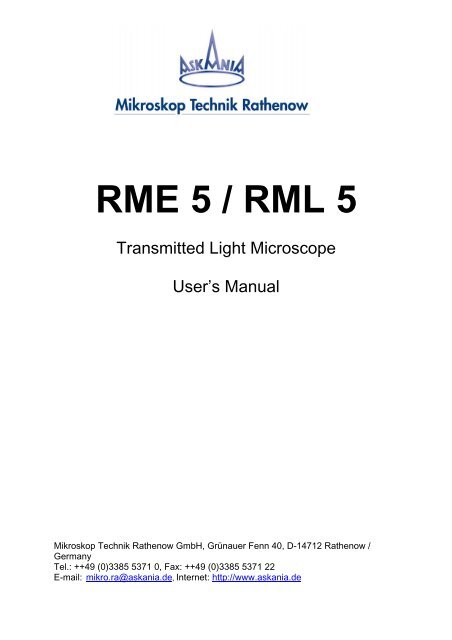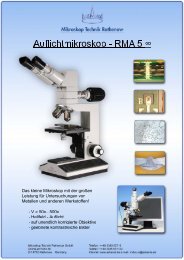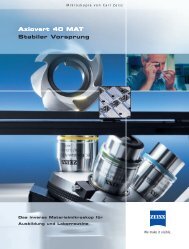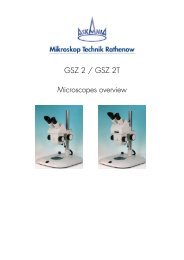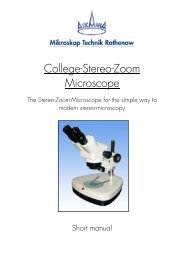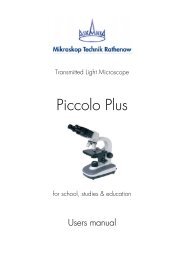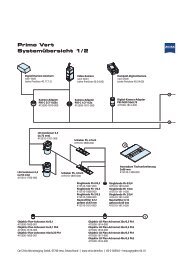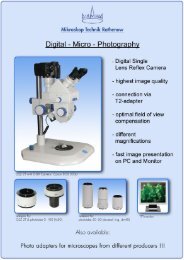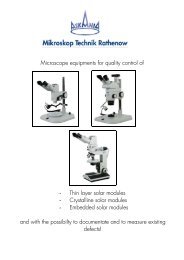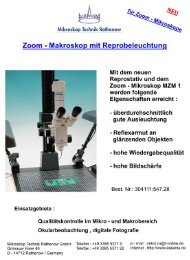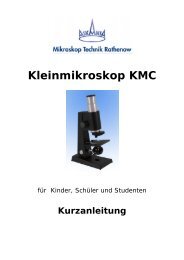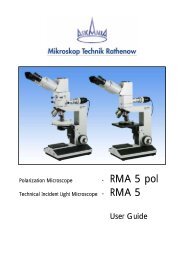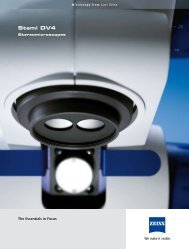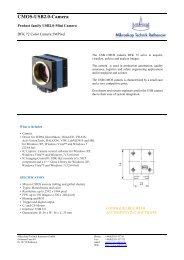RME 5 / RML 5 - Mikroskop Technik Rathenow Gmbh
RME 5 / RML 5 - Mikroskop Technik Rathenow Gmbh
RME 5 / RML 5 - Mikroskop Technik Rathenow Gmbh
Create successful ePaper yourself
Turn your PDF publications into a flip-book with our unique Google optimized e-Paper software.
<strong>RME</strong> 5 / <strong>RML</strong> 5<br />
Transmitted Light Microscope<br />
User’s Manual<br />
<strong>Mikroskop</strong> <strong>Technik</strong> <strong>Rathenow</strong> GmbH, Grünauer Fenn 40, D-14712 <strong>Rathenow</strong> /<br />
Germany<br />
Tel.: ++49 (0)3385 5371 0, Fax: ++49 (0)3385 5371 22<br />
E-mail: mikro.ra@askania.de, Internet: http://www.askania.de
Transmitted Light Microscope <strong>RME</strong> 5 / <strong>RML</strong> 5<br />
Applications:<br />
This microscope is widely used in biological, pathological, pharmaceutical<br />
research and clinic examination, also is suitalbe for school teaching.<br />
Specifications:<br />
1. Mechanical tube length 160mm<br />
2. Conjugate distance<br />
3. Achromatic objectives<br />
195mm<br />
Magnification N.A. Working of distance (mm)<br />
4x 0.1 37.5<br />
10x 0.25 7.31<br />
40x (s) 0.65 0.632<br />
100x (s) 1.25 0.198<br />
4. Eyepieces<br />
Magnification Diameter of field (mm)<br />
10x Ø18<br />
5. Abbe condenser N.A. 1.25<br />
6. Focusing range 35mm<br />
7. Mechanical stage 140mm x 140mm<br />
Longitudinal /Transversal movement 76mm x 50mm<br />
8. scale value fine focus 2 µm<br />
9. Diameter of iris diaphragm Ø2mm – Ø28mm<br />
10. Interpupillary distance 55mm – 75mm<br />
11. Bulb AC 6V/20W (input 220V/50Hz)<br />
Usage:<br />
1. Put binocular into bended arm’s seat, and tighten lock screw.<br />
2. Screw objectives into nosepiece, from low-magnification to high-<br />
magnification.<br />
3. Put a specimen into the fastening unit on mechanical stage.<br />
4. Turn on light.<br />
5. Turn elevating knob to elevate condenser. And seeing diaphragm’s<br />
image from eyepiece tube you swing handle to make the diaphragm’s<br />
image coincide with aperture of using objective, at the same time you<br />
should also adjust centering screw.<br />
6. Insert a pair of eyepieces into the binocular eyepiece tube.<br />
7. To focus (set objectives 10x on):<br />
To observe by left eye, along with turning coarse focusing knob until a<br />
image is seen, then turning fine focusing knob until the image is sharpness.<br />
And now to adjust diopter ring of right eyepiece until the image appears<br />
very clear, too.
8. Adjust interpupillary distance to meet you eyes, thus the specimen’s image<br />
is clear in both of your eyes.<br />
9. To meet special demand for magnification, you can turn the nosepiece and<br />
select the needed objective.<br />
10. To obtain a satisfactory image, please make the condenser up or down.<br />
Turn brightness wheel if brightness is not enough.<br />
11. Illuminative area on the specimen can be controlled by adjusting ring.<br />
12. In order to look for the observed target, you may rotate adjusting knob.<br />
13. When you use objective 100x to observe, put a little cedaroil on the<br />
surface of the condenser and slide so as to keep full of cedaroil between<br />
the condenser and the slide, also full of cedaroil between the objective and<br />
the slide. (Clean the cedaroil with xylene after observation.)<br />
14. Put filter in filter bench if you need.<br />
15. As lock ring acts on, elevating height of the stage is limited at some<br />
position that you expect to protect objective and slide from danger.<br />
16. Turn the tension ring to adjust tension, but to protect the stage slides<br />
down, please do not make tension too small.<br />
Maintenance:<br />
1. Keep the instrument in dry and cool place, and keep away from acid or<br />
alkali. Put a dust cover over the instrument when it is not used.<br />
2. Keep lenses clear, and wipe the lenses with soft brush if there is dust or<br />
dirt on it.<br />
3. To exchange a bulb loose the lock screw and open the lid to replace the<br />
bulb.<br />
4. To exchange a fuse when it is broken out, please screw the cover of fuse<br />
box to replace it.<br />
Complete set of the instrument:<br />
Parts Specification Qty<br />
Main set 1 set<br />
Binocular 1 pc.<br />
Objectives 4x, 10x, 40x (s), 100x (s) 1 pc. of each<br />
Eyepieces GF-P 10x/18 spectacles 1 pair of each<br />
Abbe condenser N.A. 1.25 1 pc.<br />
Filters blue 1 pc. of each<br />
Cedaroil 1 bottle<br />
Dust cover 1 pc.<br />
Spare bulb 6V / 10W / 6V / 20W 1 pc.<br />
Eyecup 2 pcs<br />
Instruction 1 book


